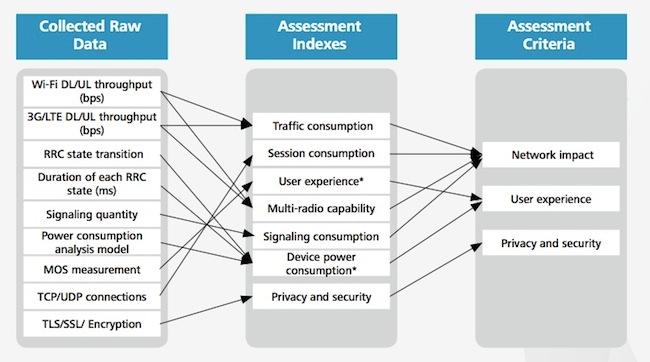Huawei has launched a collection of tools that are designed to let operators assess the performance of applications in terms of their impact on network performance, and user experience.
The vendor said its Apps Insider solution will enable mobile operators to reassign network resources for applications, and developers to improve the efficiency of their applications. The Apps Insider assesses user experience, power consumption, signaling consumption, traffic consumption and connection consumption of applications in terms of multi-radio (UMTS/LTE/Wi-Fi) capability, privacy and security.
What Huawei is offering is the process that builds a profile of apps, ranks their performance, and produces a series of recommendations for how developers and operators should optimise apps and networks for the best user experience. Huawei says that it will regularly release a network friendliness ranking of applications and provide suggestions for optimising the network friendliness of applications.
A Huawei whitepaper, “Analysing the Network Friendliness of Mobile Applications”, claims:
… developers tend to typically lack an understanding of mobile networks and the behavior of applications on mobile networks. As a result, these applications may be unfriendly towards mobile networks and cause the following problems: high terminal power consumption, frequent signaling storms on mobile networks, low utilisation efficiency of network resources, deterioration in user experience, and threats to user privacy and network security
…the network unfriendliness of smartphones and mobile applications are wasting large quantities of precious mobile network signaling resources and wireless resources, affecting user experience and posing a threat to user privacy and network security. an application network friendliness optimisation system, Huawei launched the mLAB, a mobile broadband (MBB) innovation laboratory. The mLAB provides a wireless network environment that integrates GSM, UMTS, LTE and Wi-Fi networks and the Apps Insider, an automatic tool for analyzing the network friendliness of applications.
Huawei outlines its process and objectives as follows:
● Analysis
Analyse the following data and save the analysis results into a database: Traffic Consumption (DL/UL, UMTS/LTE/Wi-Fi), RRC state transition, session number consumption, device power consumption, privacy and security measures.
● Assessment
Define baselines for assessing user experience (key QoE indexes for different application categories, e.g. MOS for VoIP, Page Loading Latency for web browsing), device power consumption, signaling consumption, traffic consumption, session number consumption, multi-radio capability, as well as privacy and security, and compare the analysis results with the baselines, score the network friendliness of each application according to the weight of each index, and arranges the order of applications according to their aggregated score.
● Optimisation
Identify key network friendliness indexes based on comparison results and provide suggestions on application development and network optimisation.
● Management
Based on statistical analysis, app platforms like the Apple App Store and Google Play would be able to formulate required network friendliness rules and criteria for published apps. End users would also be able to select apps according to their friendliness ranking.
To achieve this process Huawei has an Apps Insider client, for deployment on Android, IoS and Windows smartphones; assisstant tools such as an air interface signaling analyser, Gi interface IP packet analyser, Agilent power consumption analyser, and MOS analyser; and the Apps Insider server that collects information from the device, power consumption analyser, and Gi interface IP packet analyser, and saves the information into a database.
Huawei is not alone in targetting the "app behaviour" space — the GSMA has a Smarter App programme in place that has the support of the major NEPS, signalling and monitoring vendors are all on the case as well.



